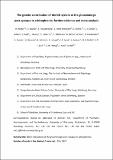The genetic contribution of the NO system at the glutamatergic post-synapse to schizophrenia : further evidence and meta-analysis
Abstract
NO is a pleiotropic signaling molecule and has an important role in cognition and emotion. In the brain, NO is produced by neuronal nitric oxide synthase (NOS-I, encoded by NOS1) coupled to the NMDA receptor via PDZ. interactions; this protein-protein interaction is disrupted upon binding of NOS1 adapter protein (encoded by NOS1AP) to NOS-I. As both NOS1 and NOS1AP were associated with schizophrenia, we here investigated these genes in greater detail by genotyping new samples and conducting a meta-analysis of our own and published data. In doing so, we confirmed association of both genes with schizophrenia and found evidence for their interaction in increasing risk towards disease. Our strongest finding was the NOS1 promoter SNP rs41279104, yielding an odds ratio of 1.29 in the meta-analysis. As findings from heterologous cell systems have suggested that the risk allele decreases gene expression, we studied the effect of the variant on NOS1 expression in human post-mortem brain samples and found that the risk allele significantly decreases expression of NOS1 in the prefrontal cortex. Bioinformatic analyses suggest that this might be due the replacement of six transcription factor binding sites by two new binding sites as a consequence of proxy SNPs. Taken together, our data argue that genetic variance in NOS1 resulting in lower prefrontal brain expression of this gene contributes to schizophrenia liability, and that NOS1 interacts with NOS1AP in doing so. The NOS1-NOS1AP PDZ interface may thus well constitute a novel target for small molecules in at least some forms of schizophrenia.
Citation
Weber , H , Klamer , D , Freudenberg , F , Kittel-Schneider , S , Rivero , O , Scholz , C -J , Volkert , J , Kopf , J , Heupel , J , Herterich , S , Adolfsson , R , Alttoa , A , Post , A , Grussendorf , H , Kramer , A , Gessner , A , Schmidt , B , Hempel , S , Jacob , C P , Sanjuan , J , Molto , M D , Lesch , K -P , Freitag , C M , Kent , L & Reif , A 2014 , ' The genetic contribution of the NO system at the glutamatergic post-synapse to schizophrenia : further evidence and meta-analysis ' , European Neuropsychopharmacology , vol. 24 , no. 1 , pp. 65-85 . https://doi.org/10.1016/j.euroneuro.2013.09.005
Publication
European Neuropsychopharmacology
Status
Peer reviewed
ISSN
0924-977XType
Journal article
Collections
Items in the St Andrews Research Repository are protected by copyright, with all rights reserved, unless otherwise indicated.

